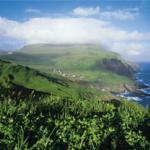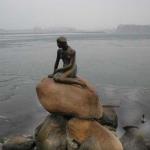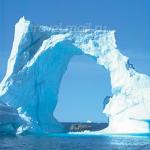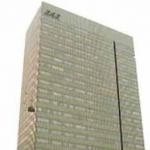Denmark Sights
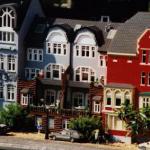 Denmark - a picturesque villages and towns, castles and monuments of past centuries, the cool shady beech forests and beautiful lakes. The coastline varies from the broad sandy beaches of the western part to the small rocky bays and fjords neat, dunes and cliffs to the north.
Denmark - a picturesque villages and towns, castles and monuments of past centuries, the cool shady beech forests and beautiful lakes. The coastline varies from the broad sandy beaches of the western part to the small rocky bays and fjords neat, dunes and cliffs to the north.Copenhagen was founded in 1167 in the northeast of the island of Zealand as a fortress and is the capital of the country with the 1417 compact historic center of Copenhagen - Indra Beau, formed inside the fortress walls of Eric VII of the island Slotsholmen ( "Castle Island"), separated from the rest City channel Frederiksholmz, and is a maze of old streets, parks (Copenhagen - one of the most "green" capital of Europe), alleys and squares, where there are many small monasteries. Center city is the Town Square with its Town Hall located at (1892 - 1905), the sculpture of the founder of the city - Bishop Absalon, the original thermometer with mechanical figures and the city museum.
At Slotsholmene is also built in 1928 at the site of the old castle of Bishop Absalon (XII century). Christiansborg Palace, which housed sechas Parliament, government agencies and the Royal ceremonial apartments. In one of the wings of the palace also contains the Museum of Carriages and the Museum of the theater. Also interested in the palace chapel, the Thorvaldsen Museum, the Stock Exchange Borsov (XVII century.) Marble Bridge and the main entrance to the Palace Christiansborg.
The largest city square - Kongens-Nitorv ( "New King"). Here are the equestrian statue of Christian V, the Royal Academy of Fine Arts (1754) with the exhibition halls in the premises of the former royal residence Sharlottenborg (1683) and the Royal Theater (1722). Nearby are the National Library and the Royal Arsenal Museum with collections of old clothes, carriages and guns. Area adjacent to the picturesque canal Nyuhavn (1673), which are laid on the old court. District Nyuhavn ( "New Harbor") - a favorite place of artists, photographers, journalists and tourists, located next to Nyuhavn National Museum and Art Gallery Carlsberg (New Glyptotek, 1888) with a winter garden and a rich collection of French and Danish art as well as numerous luxury hotels and prestigious restaurants. And a 10-minute walk north of the city center, on the waterfront, you can see the symbol of the city - the famous Little Mermaid statue.
To the west lies the municipality building Slotsholmena Tyne Hall with the famous astronomical clock and the adjacent area of same name, which starts from the main shopping district - Stroget (Streget), the center's most famous stores in the city and the beautiful pedestrian zone. Stroget surrounded by this labyrinth of narrow streets and ancient squares where you can make any purchases or simply walk. You can also visit the nearby Museum of Guinness World Records Museum and the erotic.
South of Tyne Hall stretched built on the site of former fortifications of the famous amusement park Tivoli (1843), which is decorated with a huge number of flower gardens (over 160 thousand colors), fountains, garlands of colored lights, etc. The park also has a beautifully palace of Tivoli, open theaters, many small lakes, restaurants, dance halls, cafes and dozens of original attractions.
Traditional symbols and decorations Copenhagen are his locks - Hristianborg, Rosenborg, Amalienborg Palace and Frederiksborg.
The palace complex of the royal winter residence of Amalienborg (1749 - 1760 gg.) Situated to the north-east of the city center, surrounded by these beautiful buildings of the area with horse monument Federico V. Near the palace stands the famous Marble Church (1749 - 1770 gg.), Which is about the ritual ceremony of changing of the palace guard of honor - one of the favorite all the "show" of the capital, and nearby is the Orthodox Church of Alexander Nevsky (1864).
Rosenborg Castle (Rosenborg, 1632) is surrounded by a small park and is famous for its Museum of the Danish kings (1858), with a remarkable collection of the royal family jewels and excellent art exhibition. Frederiksborg Palace (1602, rebuilt in 1859) is located north of the capital - in Hillerød on three small islands in the middle of the lake, and is famous for its interiors and the Knight's Throne Halls, and miraculously survived the fire the Castle Church. The zoo is located west of the palace - one of the biggest zoos in Europe (more than 2 thousand species of animals).
District "new town" - Christianshavn was built on the orders of King Christian IV in the early XVI century. Today there attracted the attention of the Danish Film Museum, the Round Tower and Cathedral Fort-Frou-Kirke (1829) with the famous sculpture, Thorvaldsen's "Christ and the twelve apostles" inside. On the outer wall of the bell tower mobora top leading outdoor spiral staircase of 400 steps, climbing through which you can enjoy the unforgettable panorama of the capital of Denmark. Nearby, on the island Amo, is a unique and totally separate entity of the capital, refuge rebellious youth and the focus of freedom "- an area" free city "Christiania. This is the only place in Copenhagen, where cannabis is sold freely, will be charged 25% of the first VAT on goods and services, and the rhythm and style of life radically different from traditional notions of quiet and calm in Denmark. You can visit the Church of Fort Frelsers-Kirk and the Royal Danish Naval Museum, with more than 300 mock-ups of ships and excellent historical exposition.
The wealth and abundance of its museums Copenhagen is among the best museum centers of Europe. Places of interest located in the district Nyuhavn National Museum of Denmark in the Nordic region's largest collection of Greek pottery, as well as magnificent collections of archeology, religious art, clothing, weapons, decorative arts and crafts, etc. The jurisdiction of the National Museum are also entertaining the Children's Museum, Museum of the History of Danish industry Brede in a former textile factory, Historical open air museum, the Museum of Danish Resistance and the Viking Ship Museum.
In the luxurious mansion near the park Acute Anleg placed Hirshprunga art collection - one of the best collections of Danish art of the XIX century. 30 km north of the capital are gothic castle summer residence of the queen and one of the most famous European museums of modern art - "Louisiana."
In the vicinity of the capital is interesting to visit with his Hillerød Frederiksborg Castle and the National Museum of History. In Roskilde, the former capital and largest ecclesiastical center of the country, be sure to visit the local cathedral (1170), Bishop's Palace and the unique Viking Ship Museum. Elsinore is located Kronborg Castle (1577 - 1585 gg.), Which supposedly lived Shakespeare's Hamlet, is also an interesting museum of navigation Carmelite monastery and church of St. Olaf (XV cent.). And surrounded by the sea on the northern coast. Zealand north of Copenhagen is a favorite vacation spot, and the Danes and tourists - there are dozens of beautiful beaches, first class hotels and yacht clubs, vibrant nightlife and the quiet forest.
Lying south of the island of Zealand Lollann best suited for active recreation with excellent opportunities for golf, fishing, water sports and cycling. Broken by bays and framed by limestone cliffs of the coastline Lollanna, however, as the nearby islands of Falster, Storstroem and Maine, offers a great opportunity for a quiet secluded holiday near the center of Europe, just a few minutes drive from all the benefits of civilization. A spectacular white limestone cliffs Mens Clint, rising to 128 meters above sea level on the island of Man, considered one of the most beautiful places in Denmark.
The second-largest in the country, the island of Fyn - real open-air museum, the birthplace of Hans Christian Andersen and a paradise for fishermen (fishing permit is required). The port city of Nyborg is proud to be the title of the first capital of Denmark and its castle Danehof (1170) - the oldest royal castle in Scandinavia. Odense is famous as the birthplace of the famous storyteller G.-H. Andersen, so it is usually visit for a visit to the museum Andersen. But besides him, in the city interested in the house where he lived a great storyteller as a child, as well as the Cathedral of St. Knud (XI cent.) Museum of traditional peasant architecture "Fyundskaya Village and numerous squares and parks of the city, adorned with statues of heroes andersenovskih tales. To the south of Odense is famous castle Egeskev ( "oak forest"), built in 1554 in the middle of a small lake and surrounded by beautiful English park area of more than 15 hectares. In the castle runs the car museum with more than 300 exhibits. In lying to the north-east of the resort town of Odense Kerteminde be sure to visit the Cathedral of St. Lawrence (XV cent.) And the house-museum of I. Larsen, and along the southern shore of the island - dozens of traditional villages and small towns with charming rural churches, old mansions and parks, as well as hundreds of cozy coves and small islands.
Field Jutland stretches for 400 km. from the German border to the northern tip of Denmark - Cape Skagen (Grenier). West coast of Jutland has excellent sandy beaches (swimming is often dangerous because of the constantly changing winds and currents), and east is framed by steep slopes at the base are "hiding" cozy sandy beaches. The surrounding seas and straits of the peninsula, along with countless rivers and lakes, make this part of the country at the present place of pilgrimage for fans of water sports.
The capital of East Jutland and the second largest city in Denmark - Aarhus (X cent.), Is the birthplace of Vitus Bering and major university center of the country. "Old Town" Den Gamla-Beau is centered around the cathedral of St. Clement (XIII century., The largest church of Denmark), with its famous organ (XVIII cent.), And the famous church of Fort Fru-Kirke (XIII century.) Viking Museum and the Museum of the Old City, where the open air from across the country collected more than 75 houses, whose age exceeds 400 years. In Aarhus, situated summer estate of the Danish queen, while in the suburb of Billund - the world-famous Legoland Park, which built working models of the most famous places in Europe of 42 million components of children's designer Lego, towered medieval castles, working safari park and many attractions, Dozens of children's cafes and restaurants, as well as the Toy Museum.
In Aalborg is to visit the home of Jens Bang (1624), which is considered one of the most beautiful Renaissance buildings in northern Europe, the cathedral Budof Domkirke (XIV century.) Aalborg Castle (XVI cent.), City Hall (XVII century). Tracery with internal staircase and a huge hall city council, the monastery (XVI cent.), the Historical Museum and the great North Jutland Art Museum with a collection of contemporary art, as well as the largest Viking burial in the country.
In Fredericia (founded in 1650) are interesting Trinitatis Church-Kirk and City Museum. In Esbjerg - Art Museum and the Museum of printing presses. In medieval religious center lure local tourists Ribe Cathedral (1150), an old coaching inn "Weiss-Shtu" (1600) and, again, - a huge Viking Museum. In the old capital of Jutland - Viborg, interesting cathedral (seat of the coronation of Danish monarchs, XII cent.) And the old town hall, which today houses the Museum "Skovgard.
The resort village of Skagen attractive sand dunes and beaches of the cape of the same name, as well as the Skagen Museum with a good collection of paintings and the church Den Tilsandede-Kirke (the graveyard the church ", XIV cent.), So called because covered the whole district, including the first floors of the church, the sand dunes. And around the town of Silkeborg stretched picturesque national park, the Lake District. National Parks Hessel and pile retain the pristine landscape of northern Europe, so excursions, they also considered an integral part of the country visit.
